
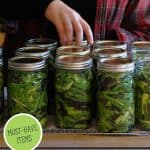
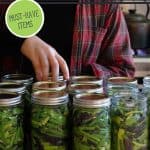
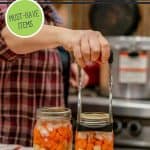
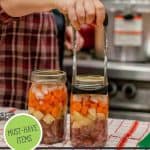
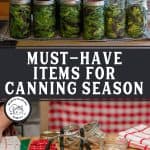
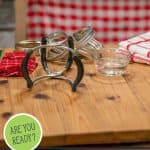
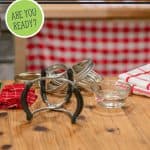
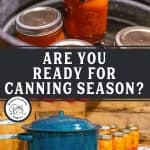

We always like to be prepared, and being ready and prepared for the preservation season is no different. With the shortage of canning supplies that continues to linger, it’s a good idea to stock up on the supplies you’ll need to preserve your food now, rather than waiting until your crops have been harvested. Here’s what we do to get ready for preservation season.
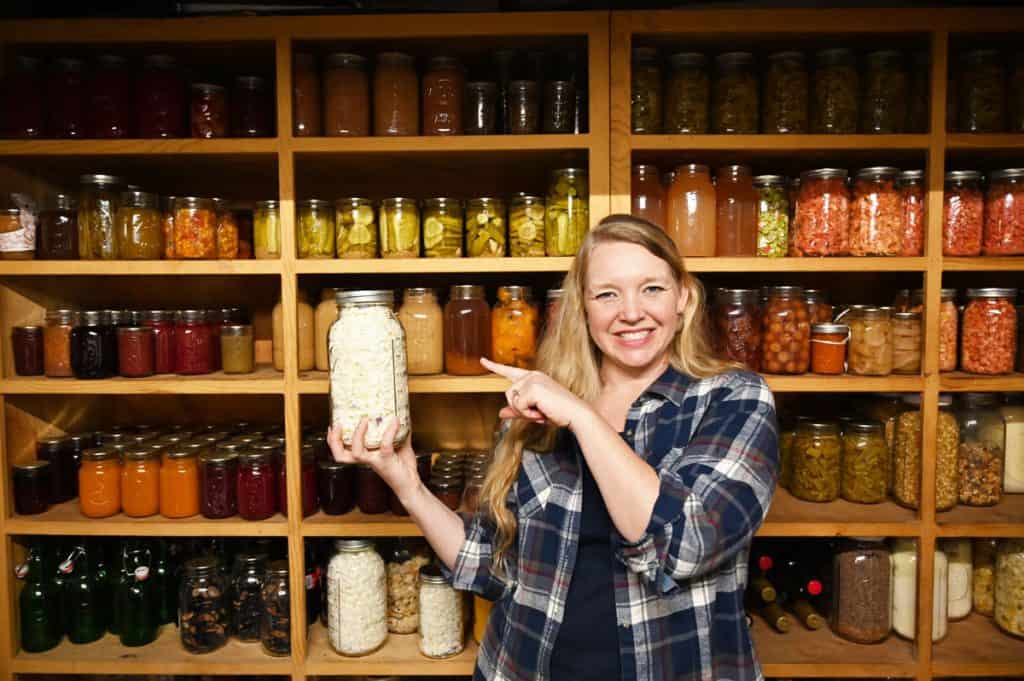
Whether we’re pressure canning homemade bone broth or our favorite beef stew, water bath canning the crunchiest pickles ever, dehydrating our favorite fruit leather, or freeze-drying our surplus of farm-fresh eggs, there’s nothing worse than having the harvest come in from the garden, only to realize you’re out of a pivotal supply.
We like to use this time of year, before or after the garden has been planted, but certainly before the harvest is ready to come in to be preserved, to take inventory of all our canning and favorite freeze-drying supplies and get our stores topped off to ensure we don’t run out of an important item just as our crops are ready for preserving.
You work so hard all spring and summer to grow a garden and bring an abundance of food into the home for your family. One of the reasons we’re so passionate about preserving food is because we love to reap the benefits of the garden all year, even during the months when it’s no longer productive.
So, each year, right about when I start seeing the cherry blossoms blooming, it reminds me that it’s about time to check all my preservation supplies. I want to be ready to can cherries soon.
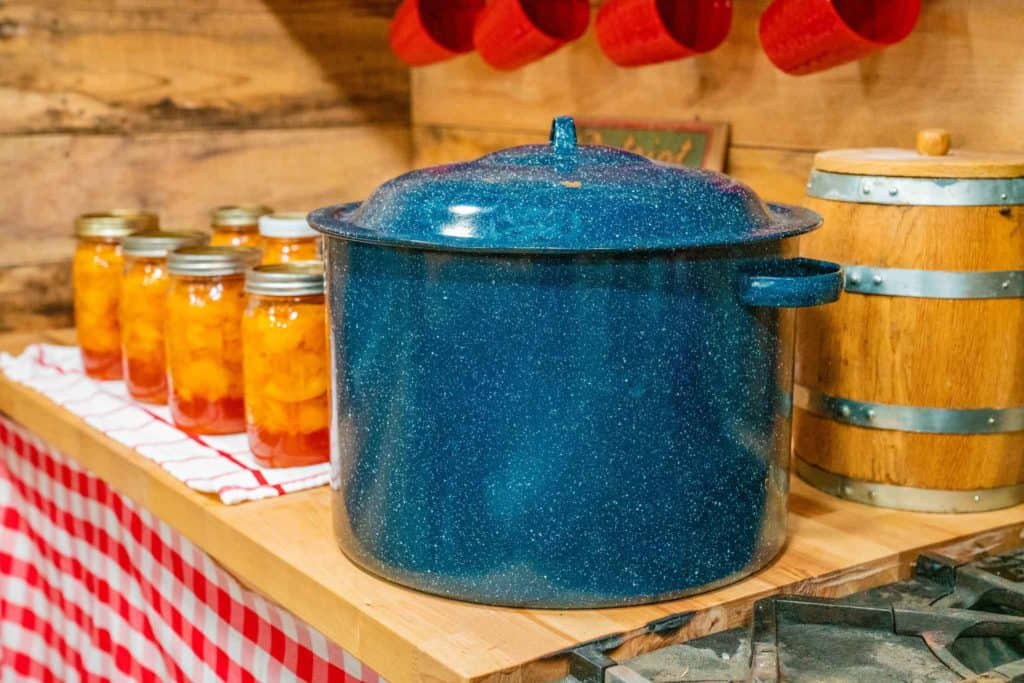
Take Inventory of Your Supplies
The first order of business, before you even look at your supplies, is to take inventory of last year’s harvest. We wrote an entire post just on preparing your pantry for the preserving season, so we recommend you go take a look at that post as well.
When taking inventory of your supplies, it’s important to walk through each preservation method to make sure you have what you need.
When checking your canning supplies, you’ll want to take a look at your canning jars and ask the following questions…
- Do you still have enough jars for the upcoming harvest?
- Are your jars in good shape (no nicks or chips or cracks)?
- If you find you’re short on jars, be sure to go order them or pick them up from your local hardware store ASAP.
Take a look at your canners as well! If you do any pressure canning, you’ll need to take in your pressure dial gauge to get it tested. If you use weighted jigglers, make sure you know where they are, locate them, and keep them stored in an easily accessible location.
You’ll also want to check the sealing ring on the lid of your pressure canner to make sure it’s in good working order and not dry or cracked. Check your double-tier trays that go into your canners and make sure they’re all in good working order as well.
Must-Have Canning Supplies
It’s important to our family to save money by being prepared ahead of time and by buying as many items as possible in bulk. This includes canning supplies!
- Canning Lids – I buy canning lids by the sleeve from Lehman’s. They offer both wide-mouth canning lids as well as regular-mouth canning lids in large packs. When lids were extremely hard to find during the pandemic, I tried a brand called Denali and have been very pleased with them as well (using that link will save you 10% on your order!). Otherwise, you can grab canning lids in smaller quantities from Amazon.
- Canning Rings (Bands) – you don’t actually need more rings than the number of jars you’ll can in a day. Because you’re not supposed to store your jars with the rings on, you only need to have them on the jars for 24 hours after canning. In my house, we often can upwards of 100 jars in a single day, so I tend to keep more than the average household. You can find canning rings here, but they will also come with new canning jars.
- Jar Lifter (two) – I never go into any canning season without having two jar lifters that are in good working condition. I do not want to have them break right in the middle of canning without having a backup (I’ve had this happen, and it’s just too easy to drop jars or scald yourself without a jar lifter.) This is my favorite jar lifter, but this jar lifter is a decent backup as well.
- Stainless Steel Funnel (and a backup) – if you’re doing serious canning each year, go ahead and splurge the extra money for a stainless steel funnel. The plastic funnels can take on bacteria and they just don’t hold up as well to heat. Trust me, the nice wide stainless funnels are the way to go.
- Bubble Remover/Headspace Ruler – this always comes in handy for measuring headspace and removing any air pockets in the jars. It’s a smart idea to have a few of these in case you get some helpers while canning (or happen to misplace yours frequently!).
- Black Sharpie Markers – each year I treat myself to a brand new box of black Sharpie pens. No jar goes into the pantry without getting the date and the item written on the lid. Don’t bother with cute labels, they just end up being a pain to remove each year, and since we use new lids anyway, I don’t mind writing on them.
- Pomona’s Pectin – I love Pamona’s pectin because it’s not a sugar-based pectin. This means it will still gel even without sugar. The only drawback is that you have to use recipes that are specific to this pectin brand, but I like that I don’t need to add so much sugar to the jams and jellies I’m preserving (like this low-sugar strawberry rhubarb jam). No more wasting money on those tiny boxes of pectin from the grocery store! Pamona’s pectin is completely shelf-stable and will last for years.
- Thick Gel – I love Cornaby’s Thick Gel because it’s completely non-GMO made from an heirloom corn product. This is my favorite to use for pie filling. The nice thing about this thick gel is it works in a pinch to thicken sauces and gravies during the holidays, or if a friend with gluten sensitivities stops by for dinner!
- Pasteurized Apple Cider Vinegar – There’s no need to buy the good stuff if you’ll be using it for canning. I like to buy my apple cider vinegar in a 5-gallon bucket from Azure Standard. Homesteading Hack: If you’re a first-time Azure Standard customer, use coupon code “HOMESTEADINGFAMILY15” at checkout for 15% off your order of $100 or more!
- Seasonings – I also like to buy mustard seed and whole black pepper in bulk. If I didn’t grow my own dill, I’d also be buying that in bulk to always have on hand for pickles or any other recipe we tend to make a lot.
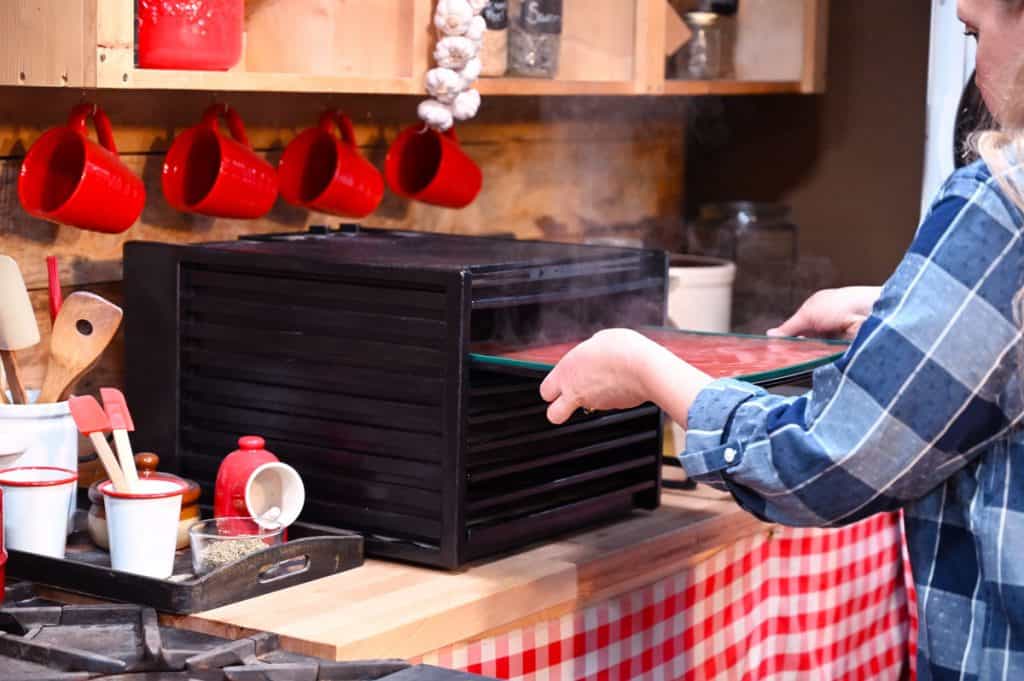
Must-Have Dehydrating Supplies
We’re doing a lot more dehydrating each year as we find recipes our family loves. So I always take inventory of my dehydrating supplies this time of year.
- Pectin – Thankfully I can use the same Pamona’s pectin I use when making jams and jellies for making my homemade fruit leather, so if I’ve done my due diligence in checking my canning supplies, this will already be taken care of.
- Dehydrator Trays – There are a variety of trays that can be used with my Excalibur dehydrator, so I like to make sure they’re all in good working condition to see if any need replacing. This company sells all kinds of dehydrator tray accessories and replacements such as the basic netted trays, the smooth non-stick sheets that are like reusable parchment paper, and my very favorite are the rimmed silicone trays I use for making fruit leather.

Must-Have Freeze Drying Supplies
With a full preserving year under our belts with our Harvest Right freeze dryer, I feel like I have a pretty good supply list of things to always have on hand. For all Harvest Right products, shop their accessories to find any additional products you need.
- Freeze Dryer Oil – You don’t want to unexpectedly run out of oil for your freeze dryer or that will completely halt your preservation season! I buy mine directly from Harvest Right, and am excited that they just came out with an oil filtration system to make the oil last even longer!
- Storage Supplies – Depending on how you’ll be storing your freeze-dried food, you’ll want to be sure you have all your supplies ahead of time. I like using Mylar bags with oxygen absorbers, as well as large canning jars with lids. We have even stored larger quantities of freeze-dried corn in five-gallon buckets with a gamma seal lid. (Find oxygen absorbers here in a 5-gallon size, 1-gallon size, and 1-quart size.)
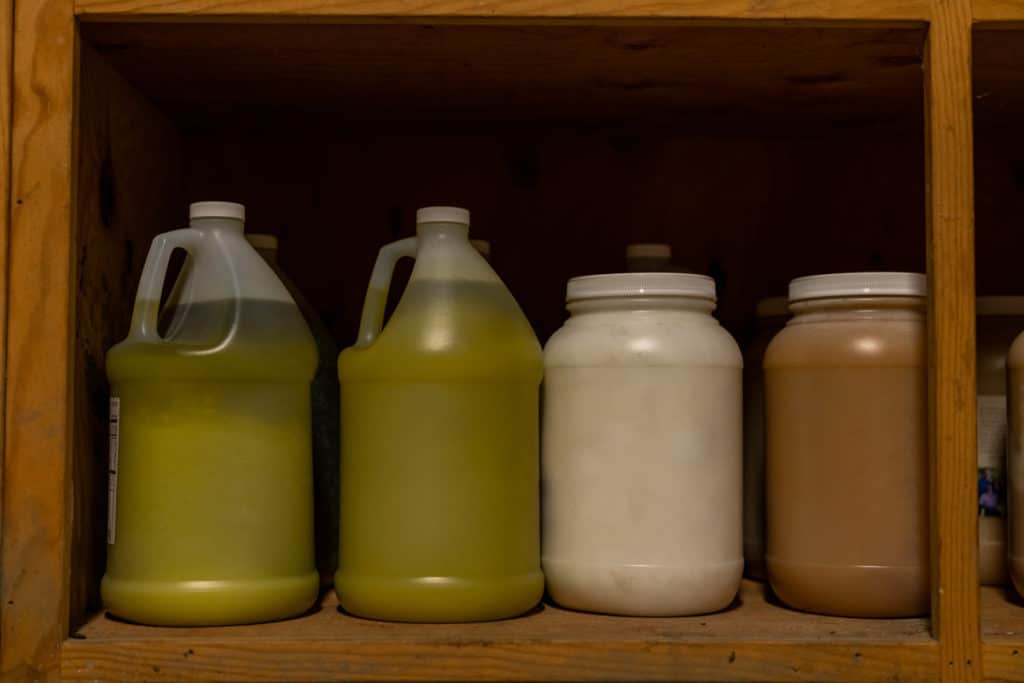
Additional Preservation Supplies
There are a few more items I always like to have on hand for the preservation year…
- Oil – I like to buy olive oil by the gallon from Azure Standard. They test each batch to ensure it’s 100% olive oil, unlike store-bought varieties. I keep this for preserving as well as making flavored oils with different herbs that come in from the garden.
- Vodka – I keep vodka on hand for making tinctures with the herbs that come in from the garden, there are also a few liqueurs I like to make for special occasions such as limoncello!
- Sugar – For all the jams and jellies we make throughout the year. This is especially helpful if someone happens to have a bunch of extra fruit they’re not going to use!
- Salt – A good quality salt that can be used for canning, preserving, and cooking is something we always have on hand. We love Redmond Real Salt because it works for anything we need to use it for (and Josh and I also got to visit the mine where they harvest the salt!). Homesteading Hack: Using that link for Redmond Salt will automatically give you 15% off your order!
Why Buy Bulk?
The above items are what I always have on hand when going into the preserving season. I always recommend buying these in bulk because they last a very long time on the pantry shelf, so you can use them from year to year.
It’s also easier to do the research on the best brands when you’re not standing at the grocery store staring at various boxes, not quite sure which brand to choose.
And finally, buying in bulk will save you money in the long run!
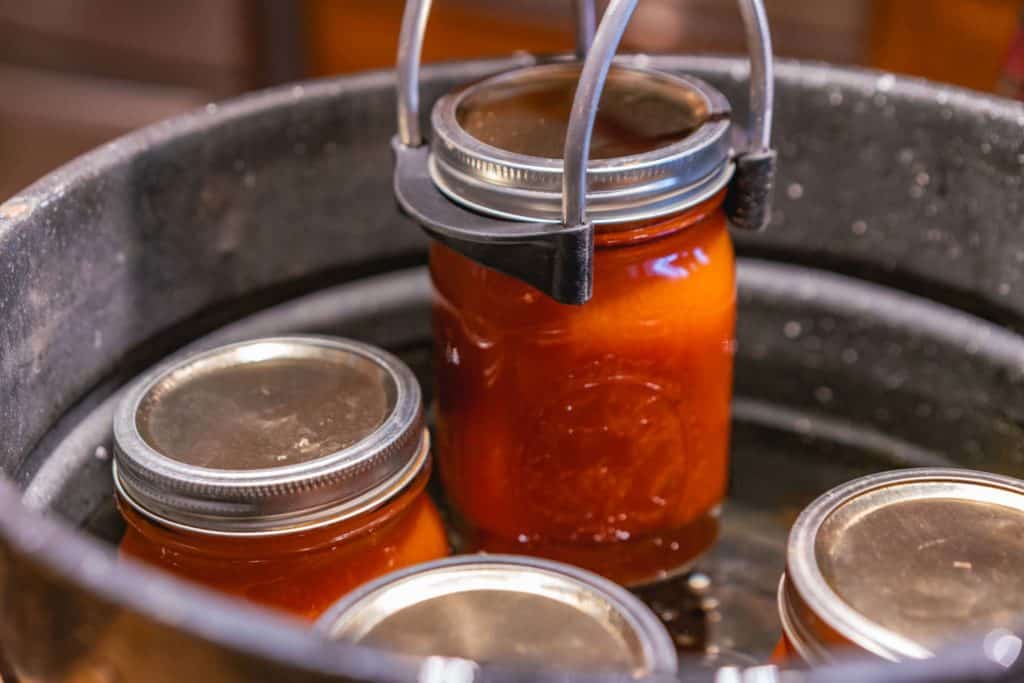
More Related Posts on Preserving:
- What to Do if You Can’t Find Canning Supplies
- Canning Mistakes to Avoid
- Pressure Canning Mistakes to Avoid
- Food Preservation Calendar (A Year-at-a-Glance)
- Can you Pressure Can in an Instant Pot?
- How Long is Canned Food Good For?
- Can I Reuse Canning Lids?
- Preserving Day Tips for Less Overwhelm
- How Full Should My Canner Be When I’m Canning?


















